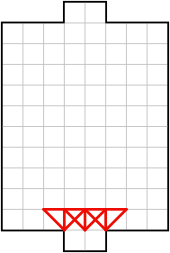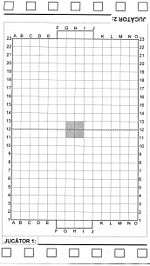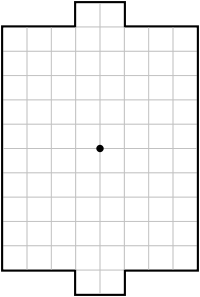Paper soccer
|
An example board | |
| Genre(s) |
Paper and pencil game Abstract strategy game |
|---|---|
| Players | 2 |
| Setup time | seconds |
| Playing time | five minutes |
| Synonym(s) | Paper hockey |
Paper soccer (or paper hockey) is an abstract strategy game played on a square grid representing a soccer or hockey field. Two players take turns to extend a line representing the position of a ball, until it reaches one of the grid's two goal spaces. A traditional paper-and-pencil game, it is commonly played in schools[1] and can be found in children's magazines.[2][3][4][5] Many computer implementations of the game also exist. Despite the game's simple rules, paper soccer has several expanded strategies and tactics.
General rules
The game's pitch is drawn as a rectangle on a grid, with small extended rectangles in the center of each of the two shortest sides to represent the two goals. The grid can be of any size, although both sides should be an even number of squares to allow a center point for kickoff. The goal areas are typically 2 × 1 squares in size.
A "ball" is marked as a dot in the center of the pitch. Players alternately move the ball to a new point by drawing a line from its current position to a new one. Each move must be to a point orthogonally or diagonally adjacent. The ball cannot be moved beyond the boundary of the pitch, nor along a line that has already been drawn.

If the ball is moved to a point which already has one or more lines connected to it (including the perimeter of the pitch), the ball "bounces" and the player immediately takes another turn. The player's move ends only when the ball reaches a point with no existing lines.
The winner is the player who places the ball in their opponent's goal. A player also wins if their opponent scores an own goal.[6] If the ball reaches a point from which it cannot be moved (such as a corner of the pitch) this is regarded as a draw, or a loss for the player unable to move, depending on the rules being played by. In some versions of the game, both of these moves can be illegal.[3][7]
Variants and modifications
The players can regulate the pitch's shape in various ways by altering the pitch's dimensions or the placement of the gates. In some variants, one or more special lines may be added to the pitch. This modification is found in computer applications,[8] and expanded variants of this modification are used by PDE Football.[9]
In some variants, gameplay can be continued from the central pitch's point after a goal is scored or after a play is blocked. The player who did not score moves first from the central point.[3] The game is finished when a move from the central point is not possible, and the player who scored the most goals wins.[10]
Another variant allows a player to make a "bounce" during any turn if the line of that bounce would cross an existing diagonal line.[11]
Strategy

Since the ball's movement cannot overlap previously drawn lines, a player can block their opponent's potential moves by filling strategic points on the board and limiting the mobility of their opponent. Another strategy is based on the use of "bounces" for streamlining mobility, which can greatly aid in scoring goals or blocking access to the player's own goal area.[9] In versions of the game where a player who cannot move loses, a player can focus on moving the ball to a position where their opponent cannot move it further.[12]
In some computerized versions of this game, the AI player tends to choose the shortest path to the player's goal, ignoring bounces and other strategies.[13]
Game notation

Each move in the game may be recorded as a string of one or more digits from 0 to 7, each digit representing the direction of a move (with 0 corresponding to 'north', 1 to 'north-east', 2 to 'east' and so on) across a single grid. Multiple digits are used to record bounce moves. This notation has been used in a PlayOk.com service.[14]
Similar games
There are two similar games which imitate paper soccer. Their mechanisms also depend on drawing lines to describe a ball's movement on a field.
Paper soccer (Russian variant)

This paper-and-pencil game also involves drawing lines to adjacent points on a grid, and is distinguished by a larger play area and players extending the line to three points each turn. The line can change direction at each point but must not touch any existing line (there are no bounce moves). If a player becomes trapped with fewer than three unoccupied points available at the start of their turn, then their turn is forfeited and the opponent gets a "penalty kick". This special move is a straight line in any of the eight compass directions, extending six points, and is the only occasion that other lines may be crossed. If the penalty lands on an already-occupied point or there are less than three unoccupied points available to move, an additional penalty kick is earned. After six such penalties, if there are insufficient valid moves then the other player starts with a penalty kick. Some versions with very large grids have players extend the line through four points per turn and penalty kicks across 13 points.
Strategy involves blocking an opponent's potential moves, outmaneuvering the opponent at the edges of the field and setting traps for penalty kicks in range of the opponent's goal. If a trap is not executed successfully, the opponent may be able to reverse it in an extreme move.[15]
The game was popular in many parts of the former Soviet Union.[15] Several Russian magazines describe the game[16][17] and there are a number of computer versions as well.[15][18][19][20]
xrSoccer
Published in 2005, xrSoccer is a computer game by eXtreme Results International Inc.[21] It may be adapted to paper-and-pencil form for two players. It has common features to the previously described versions of paper soccer but gameplay generally differs.
The pitch is a 14 × 20 grid (13 × 19 points) with goal gates on the shorter sides. Starting from the center point, the line is extended to three points per turn. The line can touch occupied points and cross existing lines (there are no bounce moves) but cannot move along an existing line. If a player has no place to extend the line, the computer repositions the ball on the nearest unblocked point. This can be favourable when executed properly, as the ball is usually moved depending on the last direction of the line before it became blocked, and can be used to maneuver closer to the opponent's goal. After scoring a goal, the ball is reset to the center point and the game continues until all possible goals are scored.[22]
| Wikimedia Commons has media related to Paper soccer. |
References
- ↑ Marek Futrega. "Wiadomości kurnikowe, archiwalna wersja z dnia 20.04.2004" (in Polish). Archived from the original on June 9, 2004. Retrieved 2016-02-17.
- ↑ Архангельск присоединился к всемирной акции «Игротека». 2 November 2014 – via YouTube.
- 1 2 3 Anonim. "8x10 Paper soccer" (in Russian). Retrieved 2015-01-27.
- ↑ Ławicki, Mariusz. 155 gier i zabaw z dzieckiem, dziećmi i dla dzieci. p. 14. ISBN 978-83-931024-0-2.
- ↑ Joanne O'sullivean I Don't Care pp 212.
- ↑ "Google".
- ↑ Work of Line Bounder app. (lack of own goal, and getting the points for finish a gameplay by short way]
- ↑ For example it is relevant in: (, , ) or Paper Soccer for geeks, PageFootball PDE Football)
- 1 2 Elephants Will Be Mine (February 2013). "PageFootball". google play store. Retrieved 2016-02-17.
- ↑ Work of Inteligentna piłka app.
- ↑ "Интеллектуальный футбол на бумаге" (in Russian). Retrieved 2016-02-17.
- ↑ Unknown. "Rules of the Paper soccer at Playok.com" (in Polish). Retrieved 2016-03-05.
gdy któryś z graczy zostanie zablokowany (when one of players gets blocked)
- ↑ Bartosz Tarnowski. "Gra "Piłkarzyki"". Implementacja sztucznej inteligencji (in Polish). Retrieved 2016-02-13.
- ↑ "PlayOk - statistics' resreach".
- 1 2 3 "Gridball Game".
- ↑ "Самые известные игры на бумаге".
- ↑ Olga Bogdanova, 300 лучших игр для веселой компании от бывалого тамады, приколиста и заводилы
- ↑ "TreeGame — онлайновые игры на любой вкус: настольные, карточные, интеллектуальные и азартные".
- ↑ AlHeSoft:. "P&P Soccer". Download.com. CBS Interactive.
- ↑ https://vk.com/app2152326_155300299
- ↑ eXtreme Results International, Inc. "Description of xrSoccer". Retrieved 2016-02-25.
- ↑ eXtreme Results International, Inc. (2016-02-18). "Video with download XrSoccer and show of the gameplay".
Bibliography
- Mariusz Ławicki 155 gier i zabaw z dzieckiem, dziećmi i dla dzieci pp 14 ISBN 978-83-931024-0-2, 2010 (standard version)
- Joanne O'sullivean I Don't Care pp 212 (standard version)
- "Самые известные игры на бумаге". (large playing area)
- Olga Bogdanova, 300 лучших игр для веселой компании от бывалого тамады, приколиста и заводилы (large playing area)
External links
- anonymus (2016-09-06). "Animation of gameplay on larger dimension" (in Russian). (large playing dimension)
- eXtreme Results International, Inc. (2016-02-18). "A video which shows download and the gameplay of xrSoccer".
